Leadership Lessons from Steve Jobs: Biography, Circumstances, Power and Style
VerifiedAdded on 2023/06/05
|9
|2204
|280
AI Summary
This article discusses the leadership style of Steve Jobs, his biography, circumstances that gave rise to him, sources of power and influence he used, and lessons from his leadership. Steve Jobs was a transformational leader who was passionate about his work and technology. He had a considerable trait of aspiration and vitality. Steve was a business leader who kept concentrating the rapid changing market that helped to run the organisation. He followed an autocratic leadership style and was both considered as both charismatic and transformational leader.
Contribute Materials
Your contribution can guide someone’s learning journey. Share your
documents today.
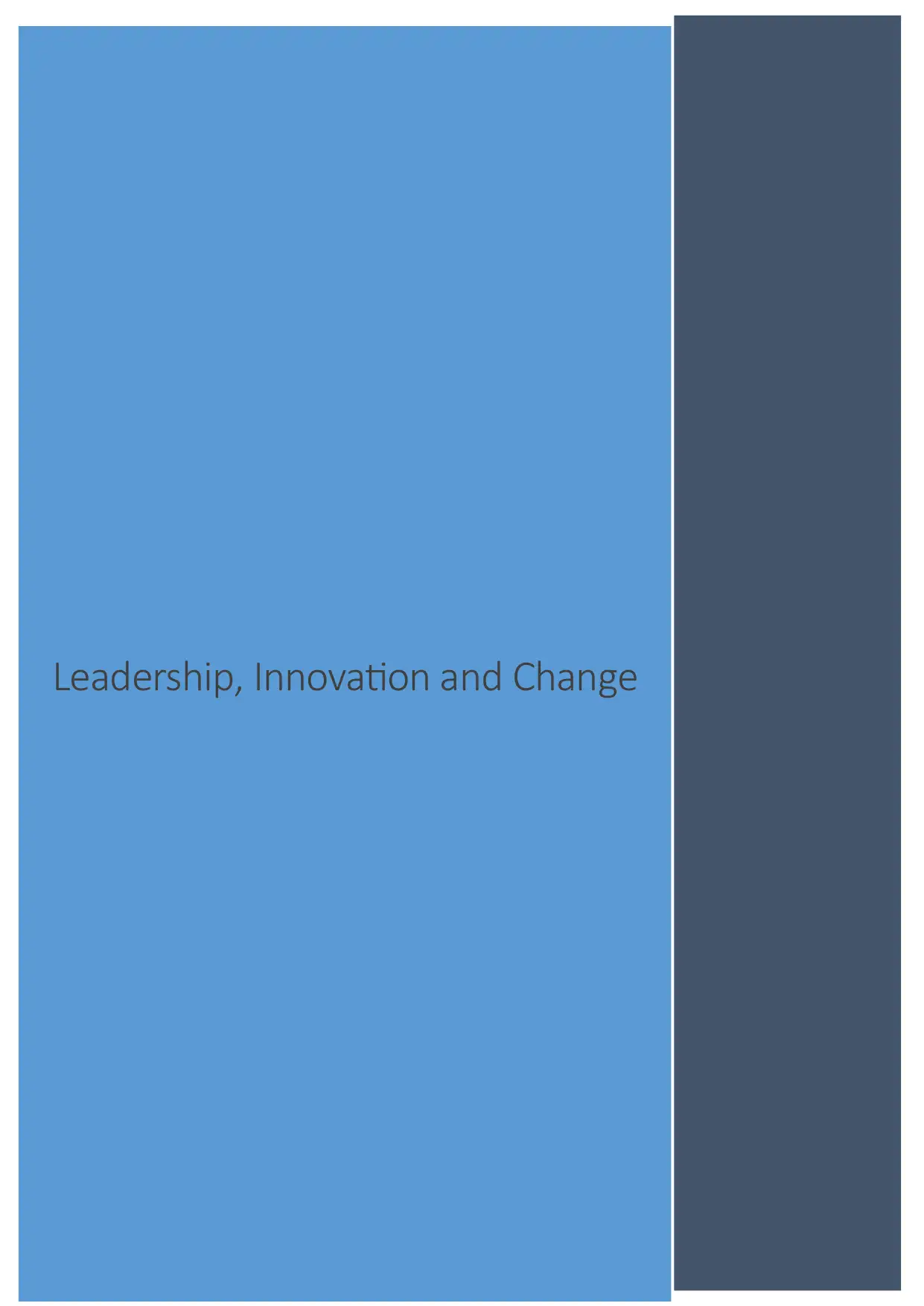
Leadership, Innovation and Change
Secure Best Marks with AI Grader
Need help grading? Try our AI Grader for instant feedback on your assignments.

LEADERSHIP, INNOVATION AND CHANGE: 1
Contents
Biography of Steve Jobs........................................................................................................................3
Circumstances that gave rise to the leader and theories are evident in the emergence of this leader.....3
Sources of power and influence the leader used....................................................................................4
Type or style of leadership followed by Steve Jobs...............................................................................5
Lessons from leadership........................................................................................................................6
References.............................................................................................................................................8
Contents
Biography of Steve Jobs........................................................................................................................3
Circumstances that gave rise to the leader and theories are evident in the emergence of this leader.....3
Sources of power and influence the leader used....................................................................................4
Type or style of leadership followed by Steve Jobs...............................................................................5
Lessons from leadership........................................................................................................................6
References.............................................................................................................................................8
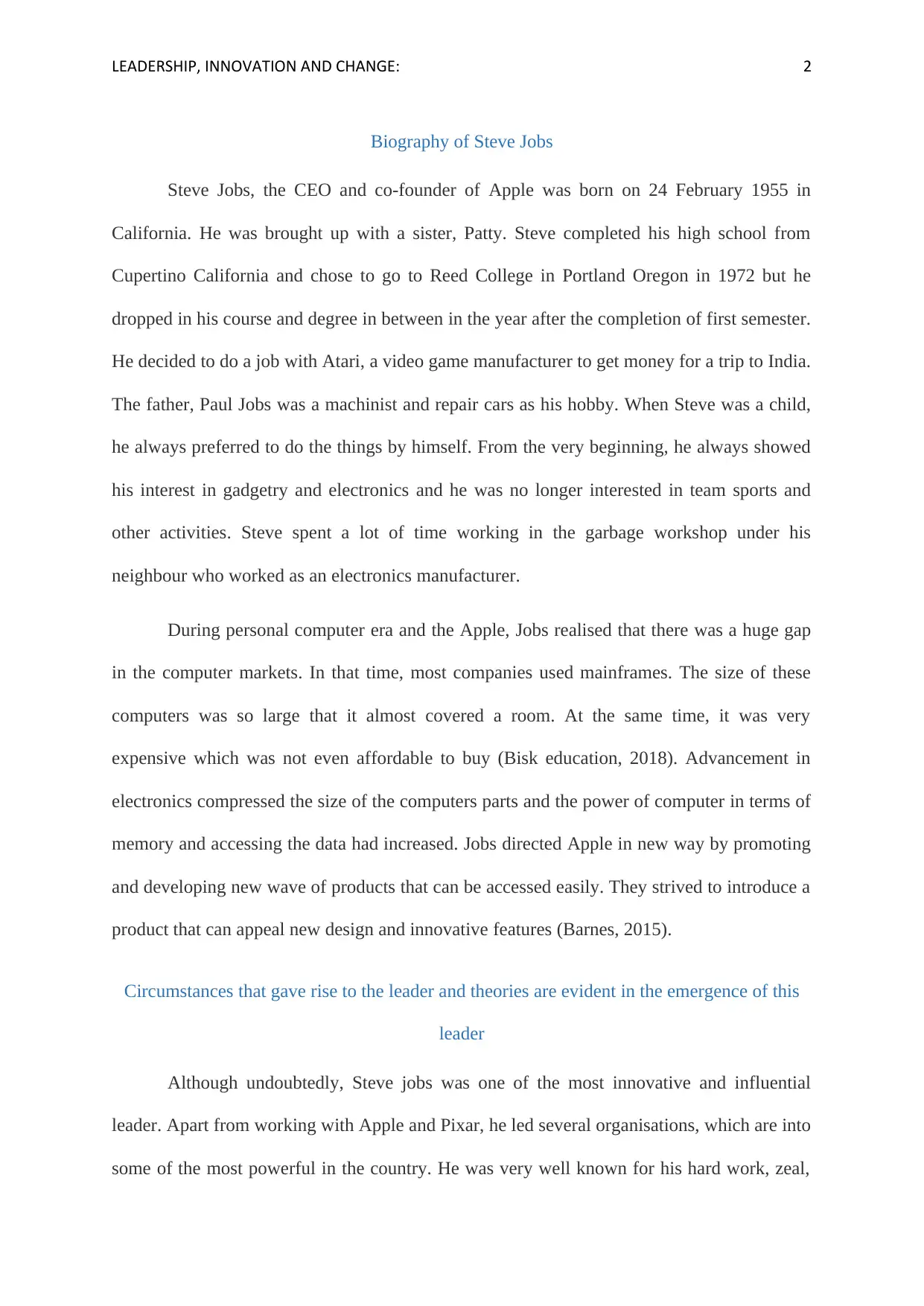
LEADERSHIP, INNOVATION AND CHANGE: 2
Biography of Steve Jobs
Steve Jobs, the CEO and co-founder of Apple was born on 24 February 1955 in
California. He was brought up with a sister, Patty. Steve completed his high school from
Cupertino California and chose to go to Reed College in Portland Oregon in 1972 but he
dropped in his course and degree in between in the year after the completion of first semester.
He decided to do a job with Atari, a video game manufacturer to get money for a trip to India.
The father, Paul Jobs was a machinist and repair cars as his hobby. When Steve was a child,
he always preferred to do the things by himself. From the very beginning, he always showed
his interest in gadgetry and electronics and he was no longer interested in team sports and
other activities. Steve spent a lot of time working in the garbage workshop under his
neighbour who worked as an electronics manufacturer.
During personal computer era and the Apple, Jobs realised that there was a huge gap
in the computer markets. In that time, most companies used mainframes. The size of these
computers was so large that it almost covered a room. At the same time, it was very
expensive which was not even affordable to buy (Bisk education, 2018). Advancement in
electronics compressed the size of the computers parts and the power of computer in terms of
memory and accessing the data had increased. Jobs directed Apple in new way by promoting
and developing new wave of products that can be accessed easily. They strived to introduce a
product that can appeal new design and innovative features (Barnes, 2015).
Circumstances that gave rise to the leader and theories are evident in the emergence of this
leader
Although undoubtedly, Steve jobs was one of the most innovative and influential
leader. Apart from working with Apple and Pixar, he led several organisations, which are into
some of the most powerful in the country. He was very well known for his hard work, zeal,
Biography of Steve Jobs
Steve Jobs, the CEO and co-founder of Apple was born on 24 February 1955 in
California. He was brought up with a sister, Patty. Steve completed his high school from
Cupertino California and chose to go to Reed College in Portland Oregon in 1972 but he
dropped in his course and degree in between in the year after the completion of first semester.
He decided to do a job with Atari, a video game manufacturer to get money for a trip to India.
The father, Paul Jobs was a machinist and repair cars as his hobby. When Steve was a child,
he always preferred to do the things by himself. From the very beginning, he always showed
his interest in gadgetry and electronics and he was no longer interested in team sports and
other activities. Steve spent a lot of time working in the garbage workshop under his
neighbour who worked as an electronics manufacturer.
During personal computer era and the Apple, Jobs realised that there was a huge gap
in the computer markets. In that time, most companies used mainframes. The size of these
computers was so large that it almost covered a room. At the same time, it was very
expensive which was not even affordable to buy (Bisk education, 2018). Advancement in
electronics compressed the size of the computers parts and the power of computer in terms of
memory and accessing the data had increased. Jobs directed Apple in new way by promoting
and developing new wave of products that can be accessed easily. They strived to introduce a
product that can appeal new design and innovative features (Barnes, 2015).
Circumstances that gave rise to the leader and theories are evident in the emergence of this
leader
Although undoubtedly, Steve jobs was one of the most innovative and influential
leader. Apart from working with Apple and Pixar, he led several organisations, which are into
some of the most powerful in the country. He was very well known for his hard work, zeal,
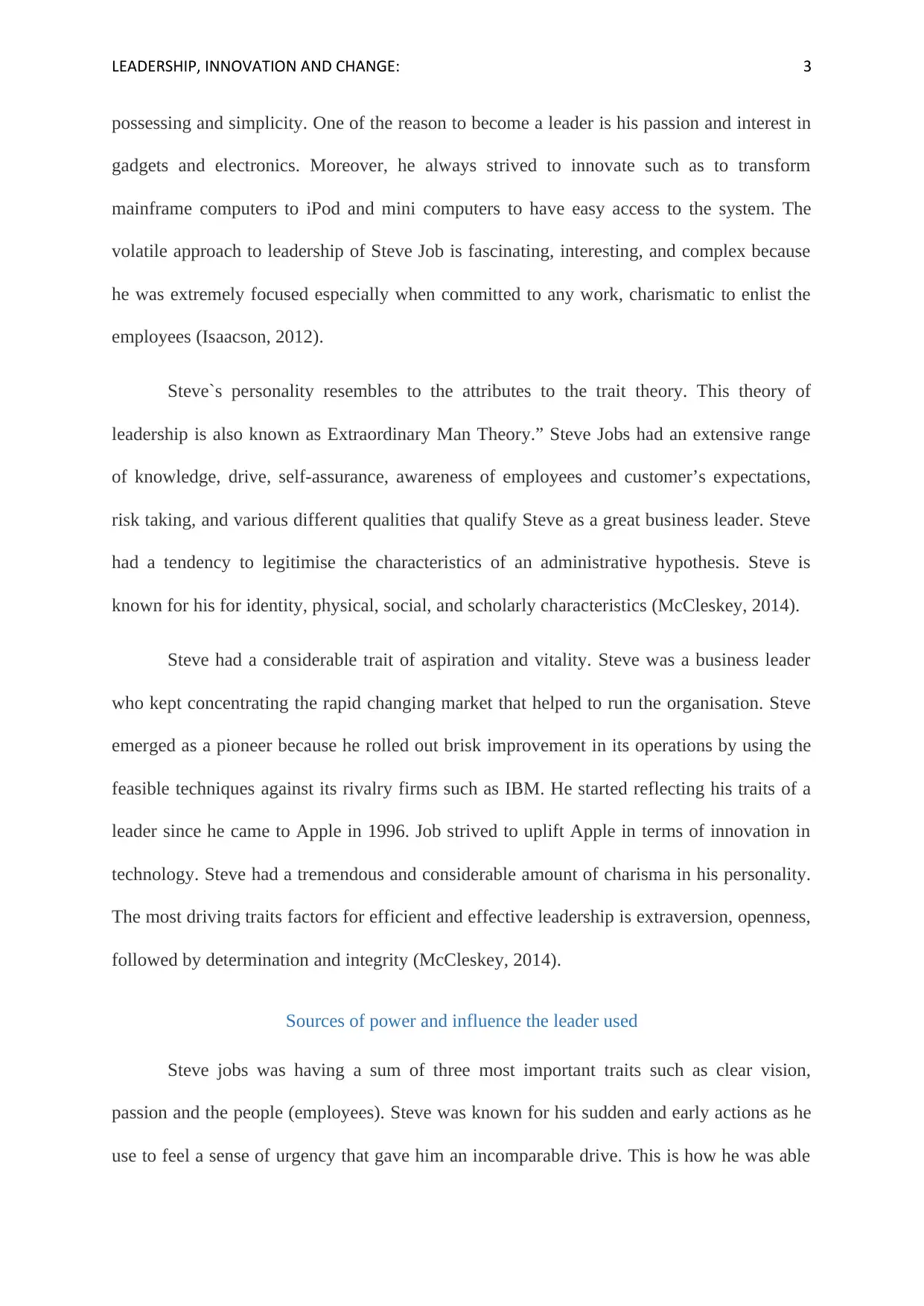
LEADERSHIP, INNOVATION AND CHANGE: 3
possessing and simplicity. One of the reason to become a leader is his passion and interest in
gadgets and electronics. Moreover, he always strived to innovate such as to transform
mainframe computers to iPod and mini computers to have easy access to the system. The
volatile approach to leadership of Steve Job is fascinating, interesting, and complex because
he was extremely focused especially when committed to any work, charismatic to enlist the
employees (Isaacson, 2012).
Steve`s personality resembles to the attributes to the trait theory. This theory of
leadership is also known as Extraordinary Man Theory.” Steve Jobs had an extensive range
of knowledge, drive, self-assurance, awareness of employees and customer’s expectations,
risk taking, and various different qualities that qualify Steve as a great business leader. Steve
had a tendency to legitimise the characteristics of an administrative hypothesis. Steve is
known for his for identity, physical, social, and scholarly characteristics (McCleskey, 2014).
Steve had a considerable trait of aspiration and vitality. Steve was a business leader
who kept concentrating the rapid changing market that helped to run the organisation. Steve
emerged as a pioneer because he rolled out brisk improvement in its operations by using the
feasible techniques against its rivalry firms such as IBM. He started reflecting his traits of a
leader since he came to Apple in 1996. Job strived to uplift Apple in terms of innovation in
technology. Steve had a tremendous and considerable amount of charisma in his personality.
The most driving traits factors for efficient and effective leadership is extraversion, openness,
followed by determination and integrity (McCleskey, 2014).
Sources of power and influence the leader used
Steve jobs was having a sum of three most important traits such as clear vision,
passion and the people (employees). Steve was known for his sudden and early actions as he
use to feel a sense of urgency that gave him an incomparable drive. This is how he was able
possessing and simplicity. One of the reason to become a leader is his passion and interest in
gadgets and electronics. Moreover, he always strived to innovate such as to transform
mainframe computers to iPod and mini computers to have easy access to the system. The
volatile approach to leadership of Steve Job is fascinating, interesting, and complex because
he was extremely focused especially when committed to any work, charismatic to enlist the
employees (Isaacson, 2012).
Steve`s personality resembles to the attributes to the trait theory. This theory of
leadership is also known as Extraordinary Man Theory.” Steve Jobs had an extensive range
of knowledge, drive, self-assurance, awareness of employees and customer’s expectations,
risk taking, and various different qualities that qualify Steve as a great business leader. Steve
had a tendency to legitimise the characteristics of an administrative hypothesis. Steve is
known for his for identity, physical, social, and scholarly characteristics (McCleskey, 2014).
Steve had a considerable trait of aspiration and vitality. Steve was a business leader
who kept concentrating the rapid changing market that helped to run the organisation. Steve
emerged as a pioneer because he rolled out brisk improvement in its operations by using the
feasible techniques against its rivalry firms such as IBM. He started reflecting his traits of a
leader since he came to Apple in 1996. Job strived to uplift Apple in terms of innovation in
technology. Steve had a tremendous and considerable amount of charisma in his personality.
The most driving traits factors for efficient and effective leadership is extraversion, openness,
followed by determination and integrity (McCleskey, 2014).
Sources of power and influence the leader used
Steve jobs was having a sum of three most important traits such as clear vision,
passion and the people (employees). Steve was known for his sudden and early actions as he
use to feel a sense of urgency that gave him an incomparable drive. This is how he was able
Secure Best Marks with AI Grader
Need help grading? Try our AI Grader for instant feedback on your assignments.
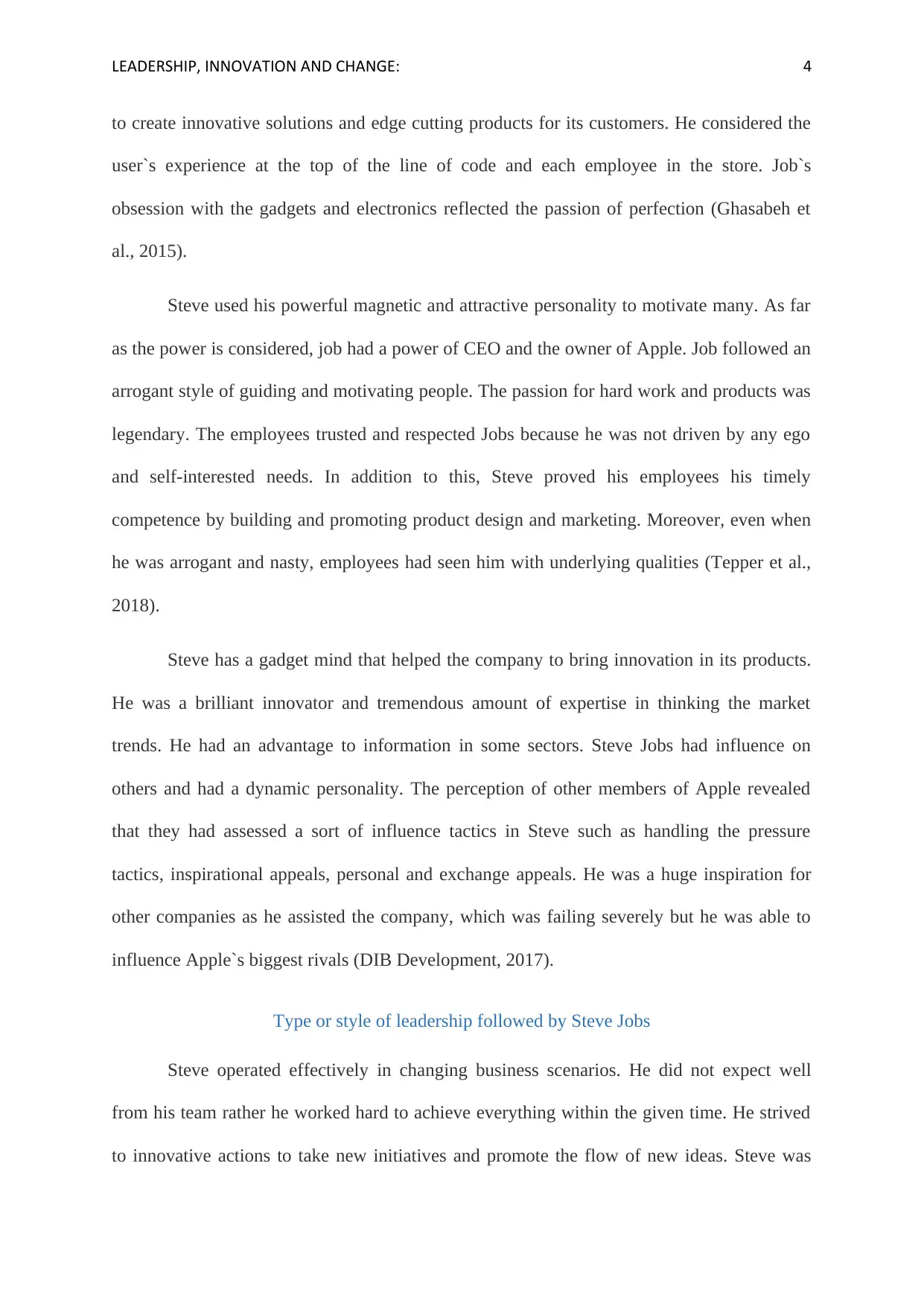
LEADERSHIP, INNOVATION AND CHANGE: 4
to create innovative solutions and edge cutting products for its customers. He considered the
user`s experience at the top of the line of code and each employee in the store. Job`s
obsession with the gadgets and electronics reflected the passion of perfection (Ghasabeh et
al., 2015).
Steve used his powerful magnetic and attractive personality to motivate many. As far
as the power is considered, job had a power of CEO and the owner of Apple. Job followed an
arrogant style of guiding and motivating people. The passion for hard work and products was
legendary. The employees trusted and respected Jobs because he was not driven by any ego
and self-interested needs. In addition to this, Steve proved his employees his timely
competence by building and promoting product design and marketing. Moreover, even when
he was arrogant and nasty, employees had seen him with underlying qualities (Tepper et al.,
2018).
Steve has a gadget mind that helped the company to bring innovation in its products.
He was a brilliant innovator and tremendous amount of expertise in thinking the market
trends. He had an advantage to information in some sectors. Steve Jobs had influence on
others and had a dynamic personality. The perception of other members of Apple revealed
that they had assessed a sort of influence tactics in Steve such as handling the pressure
tactics, inspirational appeals, personal and exchange appeals. He was a huge inspiration for
other companies as he assisted the company, which was failing severely but he was able to
influence Apple`s biggest rivals (DIB Development, 2017).
Type or style of leadership followed by Steve Jobs
Steve operated effectively in changing business scenarios. He did not expect well
from his team rather he worked hard to achieve everything within the given time. He strived
to innovative actions to take new initiatives and promote the flow of new ideas. Steve was
to create innovative solutions and edge cutting products for its customers. He considered the
user`s experience at the top of the line of code and each employee in the store. Job`s
obsession with the gadgets and electronics reflected the passion of perfection (Ghasabeh et
al., 2015).
Steve used his powerful magnetic and attractive personality to motivate many. As far
as the power is considered, job had a power of CEO and the owner of Apple. Job followed an
arrogant style of guiding and motivating people. The passion for hard work and products was
legendary. The employees trusted and respected Jobs because he was not driven by any ego
and self-interested needs. In addition to this, Steve proved his employees his timely
competence by building and promoting product design and marketing. Moreover, even when
he was arrogant and nasty, employees had seen him with underlying qualities (Tepper et al.,
2018).
Steve has a gadget mind that helped the company to bring innovation in its products.
He was a brilliant innovator and tremendous amount of expertise in thinking the market
trends. He had an advantage to information in some sectors. Steve Jobs had influence on
others and had a dynamic personality. The perception of other members of Apple revealed
that they had assessed a sort of influence tactics in Steve such as handling the pressure
tactics, inspirational appeals, personal and exchange appeals. He was a huge inspiration for
other companies as he assisted the company, which was failing severely but he was able to
influence Apple`s biggest rivals (DIB Development, 2017).
Type or style of leadership followed by Steve Jobs
Steve operated effectively in changing business scenarios. He did not expect well
from his team rather he worked hard to achieve everything within the given time. He strived
to innovative actions to take new initiatives and promote the flow of new ideas. Steve was
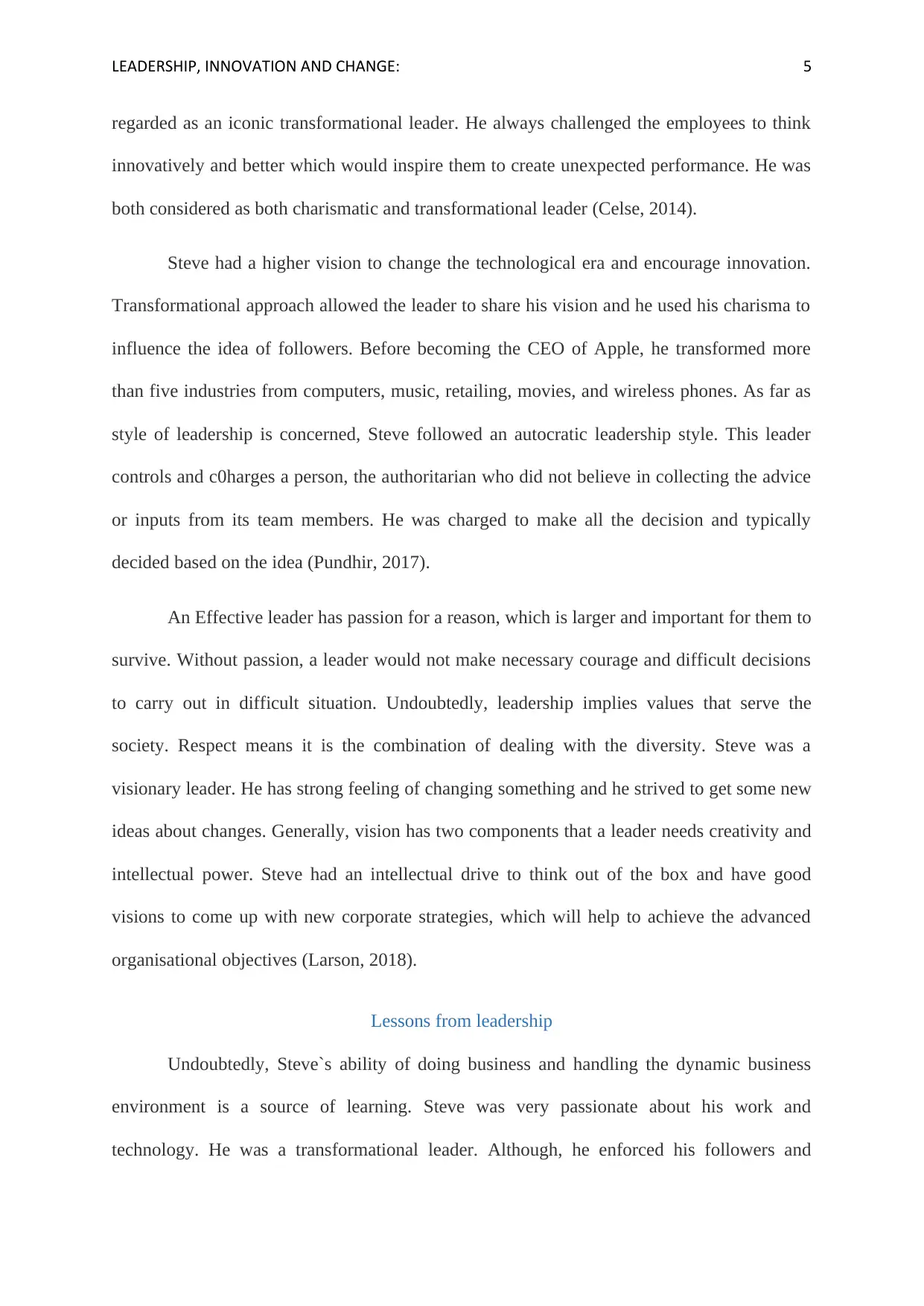
LEADERSHIP, INNOVATION AND CHANGE: 5
regarded as an iconic transformational leader. He always challenged the employees to think
innovatively and better which would inspire them to create unexpected performance. He was
both considered as both charismatic and transformational leader (Celse, 2014).
Steve had a higher vision to change the technological era and encourage innovation.
Transformational approach allowed the leader to share his vision and he used his charisma to
influence the idea of followers. Before becoming the CEO of Apple, he transformed more
than five industries from computers, music, retailing, movies, and wireless phones. As far as
style of leadership is concerned, Steve followed an autocratic leadership style. This leader
controls and c0harges a person, the authoritarian who did not believe in collecting the advice
or inputs from its team members. He was charged to make all the decision and typically
decided based on the idea (Pundhir, 2017).
An Effective leader has passion for a reason, which is larger and important for them to
survive. Without passion, a leader would not make necessary courage and difficult decisions
to carry out in difficult situation. Undoubtedly, leadership implies values that serve the
society. Respect means it is the combination of dealing with the diversity. Steve was a
visionary leader. He has strong feeling of changing something and he strived to get some new
ideas about changes. Generally, vision has two components that a leader needs creativity and
intellectual power. Steve had an intellectual drive to think out of the box and have good
visions to come up with new corporate strategies, which will help to achieve the advanced
organisational objectives (Larson, 2018).
Lessons from leadership
Undoubtedly, Steve`s ability of doing business and handling the dynamic business
environment is a source of learning. Steve was very passionate about his work and
technology. He was a transformational leader. Although, he enforced his followers and
regarded as an iconic transformational leader. He always challenged the employees to think
innovatively and better which would inspire them to create unexpected performance. He was
both considered as both charismatic and transformational leader (Celse, 2014).
Steve had a higher vision to change the technological era and encourage innovation.
Transformational approach allowed the leader to share his vision and he used his charisma to
influence the idea of followers. Before becoming the CEO of Apple, he transformed more
than five industries from computers, music, retailing, movies, and wireless phones. As far as
style of leadership is concerned, Steve followed an autocratic leadership style. This leader
controls and c0harges a person, the authoritarian who did not believe in collecting the advice
or inputs from its team members. He was charged to make all the decision and typically
decided based on the idea (Pundhir, 2017).
An Effective leader has passion for a reason, which is larger and important for them to
survive. Without passion, a leader would not make necessary courage and difficult decisions
to carry out in difficult situation. Undoubtedly, leadership implies values that serve the
society. Respect means it is the combination of dealing with the diversity. Steve was a
visionary leader. He has strong feeling of changing something and he strived to get some new
ideas about changes. Generally, vision has two components that a leader needs creativity and
intellectual power. Steve had an intellectual drive to think out of the box and have good
visions to come up with new corporate strategies, which will help to achieve the advanced
organisational objectives (Larson, 2018).
Lessons from leadership
Undoubtedly, Steve`s ability of doing business and handling the dynamic business
environment is a source of learning. Steve was very passionate about his work and
technology. He was a transformational leader. Although, he enforced his followers and
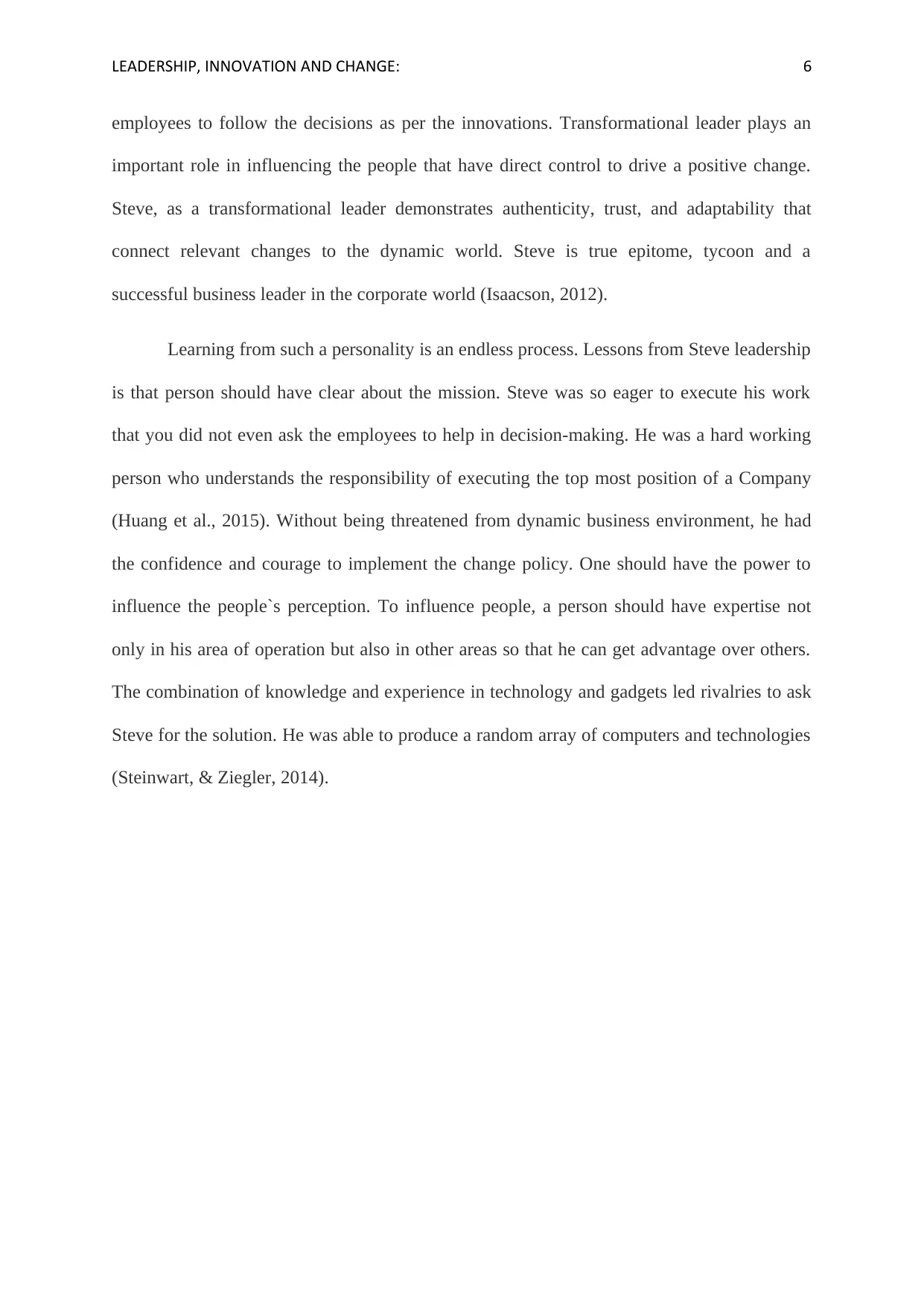
LEADERSHIP, INNOVATION AND CHANGE: 6
employees to follow the decisions as per the innovations. Transformational leader plays an
important role in influencing the people that have direct control to drive a positive change.
Steve, as a transformational leader demonstrates authenticity, trust, and adaptability that
connect relevant changes to the dynamic world. Steve is true epitome, tycoon and a
successful business leader in the corporate world (Isaacson, 2012).
Learning from such a personality is an endless process. Lessons from Steve leadership
is that person should have clear about the mission. Steve was so eager to execute his work
that you did not even ask the employees to help in decision-making. He was a hard working
person who understands the responsibility of executing the top most position of a Company
(Huang et al., 2015). Without being threatened from dynamic business environment, he had
the confidence and courage to implement the change policy. One should have the power to
influence the people`s perception. To influence people, a person should have expertise not
only in his area of operation but also in other areas so that he can get advantage over others.
The combination of knowledge and experience in technology and gadgets led rivalries to ask
Steve for the solution. He was able to produce a random array of computers and technologies
(Steinwart, & Ziegler, 2014).
employees to follow the decisions as per the innovations. Transformational leader plays an
important role in influencing the people that have direct control to drive a positive change.
Steve, as a transformational leader demonstrates authenticity, trust, and adaptability that
connect relevant changes to the dynamic world. Steve is true epitome, tycoon and a
successful business leader in the corporate world (Isaacson, 2012).
Learning from such a personality is an endless process. Lessons from Steve leadership
is that person should have clear about the mission. Steve was so eager to execute his work
that you did not even ask the employees to help in decision-making. He was a hard working
person who understands the responsibility of executing the top most position of a Company
(Huang et al., 2015). Without being threatened from dynamic business environment, he had
the confidence and courage to implement the change policy. One should have the power to
influence the people`s perception. To influence people, a person should have expertise not
only in his area of operation but also in other areas so that he can get advantage over others.
The combination of knowledge and experience in technology and gadgets led rivalries to ask
Steve for the solution. He was able to produce a random array of computers and technologies
(Steinwart, & Ziegler, 2014).
Paraphrase This Document
Need a fresh take? Get an instant paraphrase of this document with our AI Paraphraser
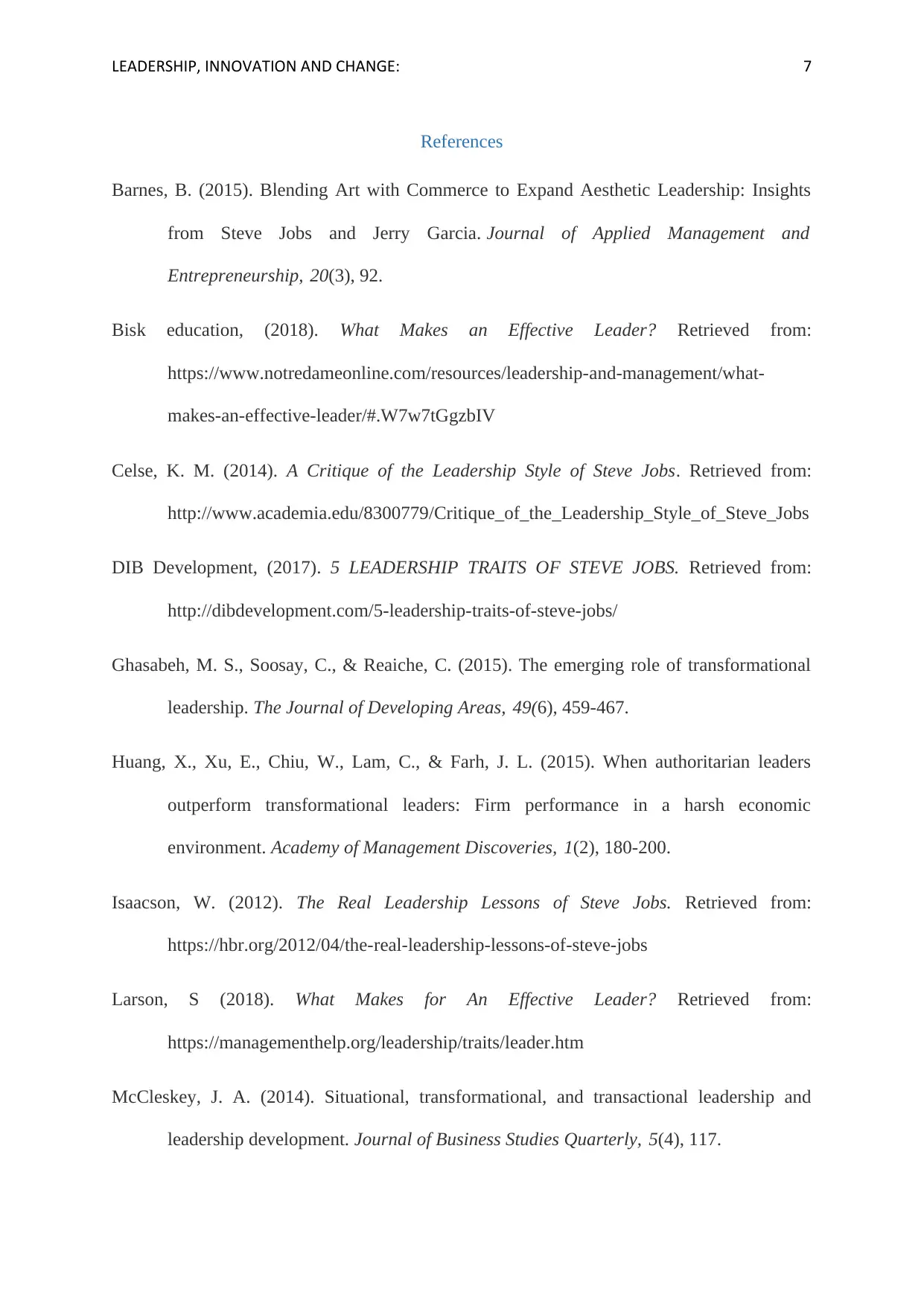
LEADERSHIP, INNOVATION AND CHANGE: 7
References
Barnes, B. (2015). Blending Art with Commerce to Expand Aesthetic Leadership: Insights
from Steve Jobs and Jerry Garcia. Journal of Applied Management and
Entrepreneurship, 20(3), 92.
Bisk education, (2018). What Makes an Effective Leader? Retrieved from:
https://www.notredameonline.com/resources/leadership-and-management/what-
makes-an-effective-leader/#.W7w7tGgzbIV
Celse, K. M. (2014). A Critique of the Leadership Style of Steve Jobs. Retrieved from:
http://www.academia.edu/8300779/Critique_of_the_Leadership_Style_of_Steve_Jobs
DIB Development, (2017). 5 LEADERSHIP TRAITS OF STEVE JOBS. Retrieved from:
http://dibdevelopment.com/5-leadership-traits-of-steve-jobs/
Ghasabeh, M. S., Soosay, C., & Reaiche, C. (2015). The emerging role of transformational
leadership. The Journal of Developing Areas, 49(6), 459-467.
Huang, X., Xu, E., Chiu, W., Lam, C., & Farh, J. L. (2015). When authoritarian leaders
outperform transformational leaders: Firm performance in a harsh economic
environment. Academy of Management Discoveries, 1(2), 180-200.
Isaacson, W. (2012). The Real Leadership Lessons of Steve Jobs. Retrieved from:
https://hbr.org/2012/04/the-real-leadership-lessons-of-steve-jobs
Larson, S (2018). What Makes for An Effective Leader? Retrieved from:
https://managementhelp.org/leadership/traits/leader.htm
McCleskey, J. A. (2014). Situational, transformational, and transactional leadership and
leadership development. Journal of Business Studies Quarterly, 5(4), 117.
References
Barnes, B. (2015). Blending Art with Commerce to Expand Aesthetic Leadership: Insights
from Steve Jobs and Jerry Garcia. Journal of Applied Management and
Entrepreneurship, 20(3), 92.
Bisk education, (2018). What Makes an Effective Leader? Retrieved from:
https://www.notredameonline.com/resources/leadership-and-management/what-
makes-an-effective-leader/#.W7w7tGgzbIV
Celse, K. M. (2014). A Critique of the Leadership Style of Steve Jobs. Retrieved from:
http://www.academia.edu/8300779/Critique_of_the_Leadership_Style_of_Steve_Jobs
DIB Development, (2017). 5 LEADERSHIP TRAITS OF STEVE JOBS. Retrieved from:
http://dibdevelopment.com/5-leadership-traits-of-steve-jobs/
Ghasabeh, M. S., Soosay, C., & Reaiche, C. (2015). The emerging role of transformational
leadership. The Journal of Developing Areas, 49(6), 459-467.
Huang, X., Xu, E., Chiu, W., Lam, C., & Farh, J. L. (2015). When authoritarian leaders
outperform transformational leaders: Firm performance in a harsh economic
environment. Academy of Management Discoveries, 1(2), 180-200.
Isaacson, W. (2012). The Real Leadership Lessons of Steve Jobs. Retrieved from:
https://hbr.org/2012/04/the-real-leadership-lessons-of-steve-jobs
Larson, S (2018). What Makes for An Effective Leader? Retrieved from:
https://managementhelp.org/leadership/traits/leader.htm
McCleskey, J. A. (2014). Situational, transformational, and transactional leadership and
leadership development. Journal of Business Studies Quarterly, 5(4), 117.
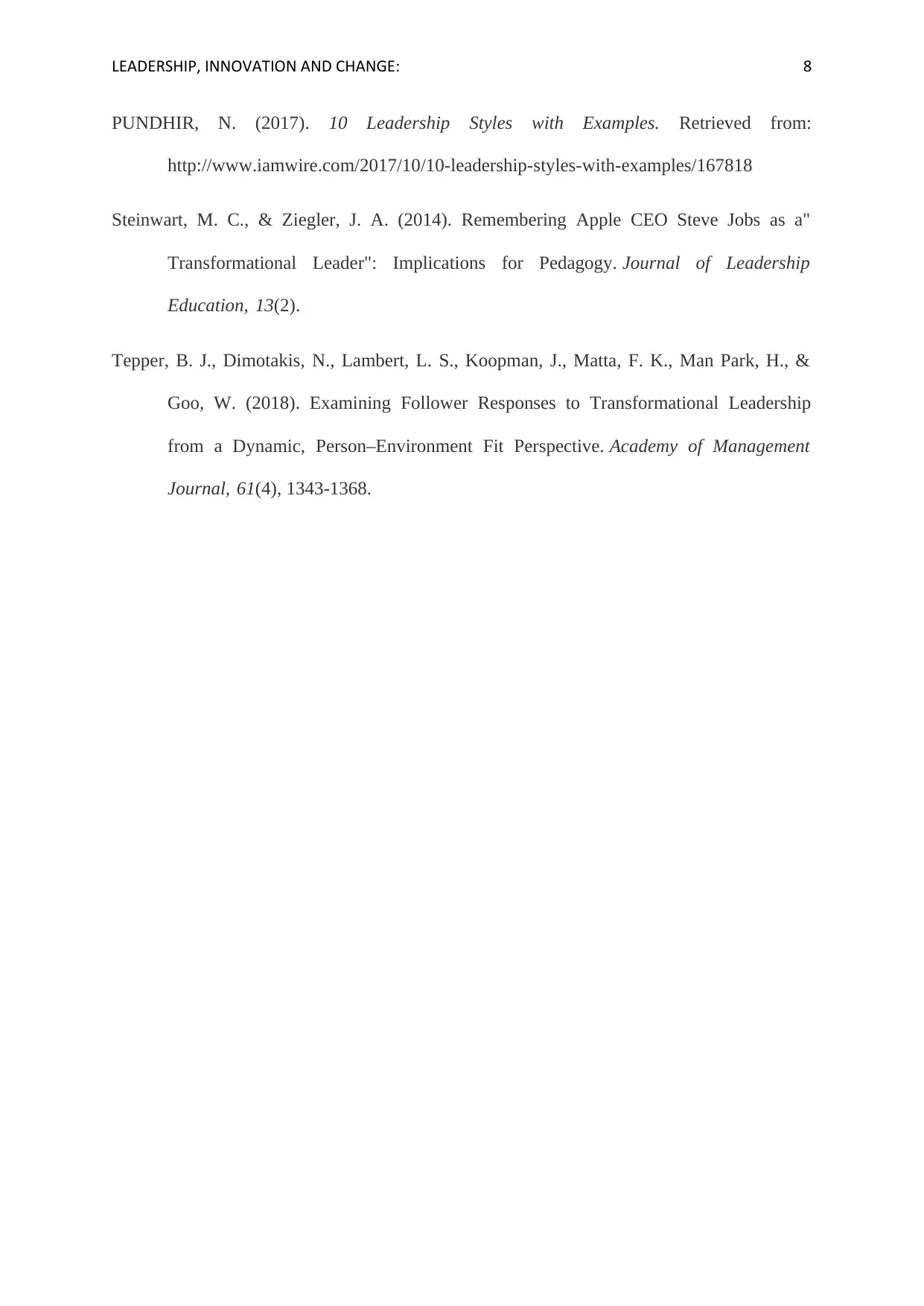
LEADERSHIP, INNOVATION AND CHANGE: 8
PUNDHIR, N. (2017). 10 Leadership Styles with Examples. Retrieved from:
http://www.iamwire.com/2017/10/10-leadership-styles-with-examples/167818
Steinwart, M. C., & Ziegler, J. A. (2014). Remembering Apple CEO Steve Jobs as a"
Transformational Leader": Implications for Pedagogy. Journal of Leadership
Education, 13(2).
Tepper, B. J., Dimotakis, N., Lambert, L. S., Koopman, J., Matta, F. K., Man Park, H., &
Goo, W. (2018). Examining Follower Responses to Transformational Leadership
from a Dynamic, Person–Environment Fit Perspective. Academy of Management
Journal, 61(4), 1343-1368.
PUNDHIR, N. (2017). 10 Leadership Styles with Examples. Retrieved from:
http://www.iamwire.com/2017/10/10-leadership-styles-with-examples/167818
Steinwart, M. C., & Ziegler, J. A. (2014). Remembering Apple CEO Steve Jobs as a"
Transformational Leader": Implications for Pedagogy. Journal of Leadership
Education, 13(2).
Tepper, B. J., Dimotakis, N., Lambert, L. S., Koopman, J., Matta, F. K., Man Park, H., &
Goo, W. (2018). Examining Follower Responses to Transformational Leadership
from a Dynamic, Person–Environment Fit Perspective. Academy of Management
Journal, 61(4), 1343-1368.
1 out of 9
Related Documents
Your All-in-One AI-Powered Toolkit for Academic Success.
+13062052269
info@desklib.com
Available 24*7 on WhatsApp / Email
![[object Object]](/_next/static/media/star-bottom.7253800d.svg)
Unlock your academic potential
© 2024 | Zucol Services PVT LTD | All rights reserved.





